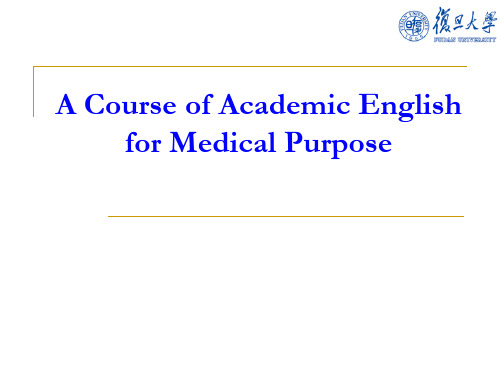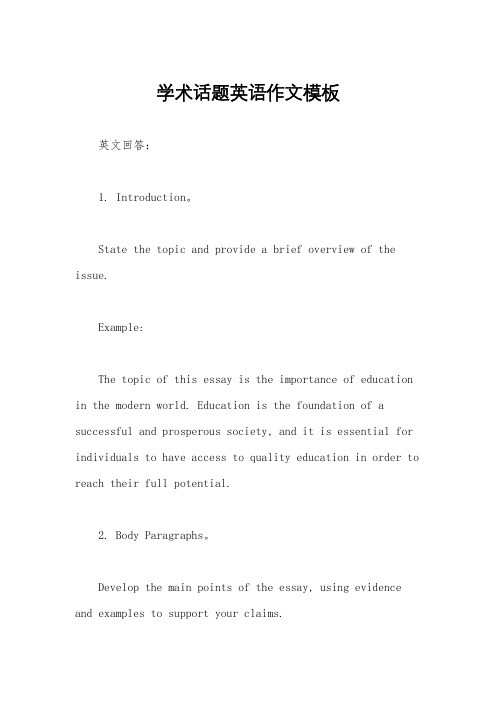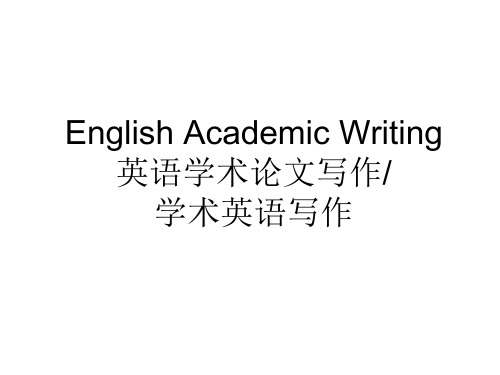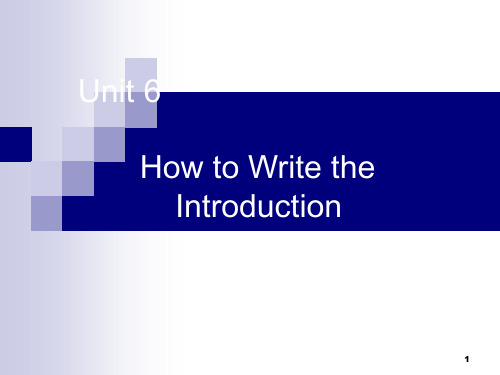学术英语introduction
学术英语(社科)Unit7原文及翻译.doc

Introduction: Understanding the Impact of New Media on Journalism 1Journalism is undergoing a fundamental transformation, perhaps the most fundamental since the rise of the penny press of the mid-nineteenth century. In the twilight of the twentieth century and the dawn of the twenty-first, there is emerging a new form of journalism whose distinguishing qualitiesinclude ubiquitous news, global information access, instantaneous reporting, interactivity, multimedia content, and extreme content customization. In many ways this represents a potentially better form of journalism because it can reengage an increasingly distrusting and alienated audience. At the same time, it presents many threats to the most cherished values and standards of journalism. Authenticity of content, source verification, accuracy, and truth are all suspect in a medium where anyone with a computer and a modem can become a global publisher.2Although the easy answer is to point to the Internet, the reasons for the transformation of journalism are neither simple nor one-dimensional. Rather, a set of economic, regulatory, and cultural forces, driven by technological change, are converging to bring about a massive shift in the nature of journalism at the millennium.3The growth of a global economic system, made up of regional economies, all interrelated (witness the volatility in the world‟s financial markets in August 1998, when drops in Asian and Russian markets triggered drops in European and U.S. markets) and increasingly controlled by multinational corporate behemoths, has rewritten the financial basis for journalism and the media in general. Deregulation, as outlined in the U.S. Telecommunications Act of 1996 and简介:了解新媒体对新闻的影响1新闻业正在发生根本性的变革,或许最根本的变革是十九世纪中叶的便士报的崛起。
英语学术文章结构的12个不同部分

英语学术文章结构的12个不同部分1. Abstract标准摘要五句话,包含五个层次的内容:1.1 Introduction: 为什么要进行本项研究,现状中本项研究的缺失或者做了但是存在不足;1.2 Method:用什么方法做这个研究;1.3 Data:用什么样的数据来验证你的方法;1.4 Results:从研究中得出什么结论;1.5 Implication:得出的结论对研究领域和实践有什么意义(理论与实践意义)2. Introduction2.1 Research background:目的是证实该研究问题的重要性。
如这一类问题造成的损失很严重,因此研究这一问题很重要。
2.2 Research problem:在上述的这一大研究背景下,要做什么问题(或者方面)的研究;在上述的这一大研究背景下,这一研究可以在哪些方面解决现存的实际问题。
2.3 研究现状:别人已经做了哪些东西,别人已经做过什么,发现了什么样的问题?2.4 现存的研究有什么问题与不足:别人有什么没有做过?为什么别人没有做得更好?并说明这些研究不足会带来严重后果。
2.5 本研究的目标(objective)和研究范围(scope):本研究弥补这些问题中(这些没做过或者做过没做好的问题中)的哪些不足,采用什么研究方法去弥补不足。
陈述本项研究的范围局限,并高度概括本论文研究结论。
2.6 文章结构:本论文的后续部分的基本内容架构。
3. Literature review目的:Literature review证明与说明两件事情:一是研究目标的设定是有意义的;二是你在本研究中采用的方法是可靠的、有效的。
包括三个层次的内容:3.1 对选题(你找到的研究问题)的justification。
即对做过没做好或者没做过的研究问题,在这个研究领域,针对research problem而言,让读者明白本项研究是有意义的;3.2 现存文献中对本文值得参考并可借鉴的东西(包括分析工具和成果);3.3 非相关或者相邻研究领域值得借鉴的东西,侧重于可借鉴的研究方法。
学术英语介绍

Assignments
Teamwork
The assignment, to be completed in a group of four or three, is to further your understanding of the text covered in class, to facilitate your actual use of target language in context, and to build cooperation with other learners.
Brief Introduction to Schedule
Assignments
Classroom Oral Presentations
You are supposed to deliver 3-minute presentations on the given topics related to the content of the text (Topics for presentation of Text A).
Final Evaluation & Grading
Objectives
To expand by a large margin their vocabulary, especially those specialized terms in medical context
Objectives
To be able to prepare and deliver presentation with/without the aid of PPT on the topics related to medicine
学术英语writingintroduction

What belongs in the introductory section(s) of your paper?
A statement of the goal of the paper: why the study was undertaken, or why the paper was written. Do not repeat the abstract.
Structural Layout of Introduction
The first layer 1.1 Introducing the general research area including its background,
Frequently asked questions
What is an introduction for? Is it a summary?
An introduction is not a summary. A summary repeats the main ideas of an essay. An introduction introduces the reader to the topic of the
What is Introduction?
Introduction is the first section of a scientific paper, including the background information of the research, the nature and scope of the problem investigated.
An essay introduction does not need to do more than tell the reader the topic of the essay, describe how the body of the essay is organized, and explain the thesis that you argue for in the essay.
学术英语(人文社科类)Unit

Quantitative Research
Learn about quantitative research , such as surveys, experiments, and statistical analysis.
Making Recommendations
Discover how to provide valuable recommendations based on your research findings.
Literature Review and Analysis in Academic Writing
1 Conducting a
Comprehensive
2 Analyzing and
Interpreting
3 Identifying
Research Gaps
Literature Review
Explore effective
Sources
Learn techniques for
Discover how to identify gaps in
research strategies to
critically analyzing
existing research and
locate, evaluate, and
scholarly sources and
学术英语(人文社科 类)Unit
学术英语(人文社科类)Unit: 用于人文社科类学术写作的英语。涵盖写作流程、 论文结构、文献综述、数据分析、学术词汇等多个主题。
学术话题英语作文模板

学术话题英语作文模板英文回答:1. Introduction。
State the topic and provide a brief overview of the issue.Example:The topic of this essay is the importance of education in the modern world. Education is the foundation of a successful and prosperous society, and it is essential for individuals to have access to quality education in order to reach their full potential.2. Body Paragraphs。
Develop the main points of the essay, using evidence and examples to support your claims.Example:Body Paragraph 1: The first benefit of education isthat it provides individuals with the skills and knowledge they need to succeed in the modern economy. In today's globalized world, employers are looking for workers who have a strong foundation in math, science, and technology.A good education can also help individuals develop critical thinking and problem-solving skills, which are essentialfor success in any field.Body Paragraph 2: The second benefit of education is that it promotes social mobility. Education can help individuals break out of poverty and achieve a better life for themselves and their families. In many countries, education is the key to unlocking opportunities for higher-paying jobs and better healthcare.Body Paragraph 3: The third benefit of education isthat it fosters personal growth. Education can help individuals develop their minds and expand their horizons.It can teach them about different cultures, histories, and perspectives. A good education can also help individuals become more tolerant and understanding of others.3. Conclusion。
学术英语写作Unit 6.Introduction(课堂PPT)

Sample Analysis
Introduction
1.Polylactide (PLA) has received much attention in recent years due to its biodegradable properties, which offer important economic benefits. 2.PLA is a polymer obtained from corn and is produced by the polymerization of lactide. 3.It has many possible uses in the biomedical field1 and has also been investigated as potential engineering material.2,3 4.However, it has been found to be too weak under impact to be used commercially.4
5.One way to toughen polymers is to incorporate a layer of rubber particles5 and there has been extensive research regarding the rubber modification of PLA. 6.For example, Penney et al. showed that PLA composites could be prepared using blending techniques6 and more recently, Hillier established the toughness of such composites.7
英语学术写作

英语学术写作英语的学术的提纲以及要点都是同学们关心的问题,那么怎样的写法才符合的标准呢?XX英语学术写作XX格式Title(标题)XXAbstract(摘要)Keywords(关键词)XXTable of contents()XXNomenclature(术语表)Introduction(引言)Method(方法)Results(结果)XXDiscussion(讨论)Conclusion(结论)Acknowledgement(致谢)Reference()Appendix(附录)XX其中Title,Abstract,Introduction,Method,Result,Discu ssion,Conclusion,Reference等八项内容是必不可少的(其他内容根据具体需要而定)。
在这八项内容中,读者最多的是Title,Abstr act和Introduction部分,读者会根据这些内容来决定是否阅读全文。
也就是说,一篇研究赢得读者的多少,在很大程度上取决于Title,Abstract和Introduction写得好坏。
因此这三项内容将**分章详细加以讲述。
学术的正文一般包括Method,Result,Discussion三个部分。
这三部分主要描述研究课题的具体内容、方法,研究过程中所使用的设备、仪器、条件,并如实公布有关数据和研究结果等。
Conclusion是对全文内容或有关研究课题进行的总体性讨论.它具有严密的科学性和客观性,反映一个研究课题的价值,同时提出以后的研究方向.XX标题的写法标题是全文内容的缩影。
读者通过标题便能够预测的主要内容和作者的意图,从而决定是否阅读全文。
因此,为了使文章赢得有关领域里众多的读者,的标题必须用最精炼的语言恰如其分地体现全文的主题和核心。
本章主要探讨英语学术标题的语言特点及写法。
6.1 标题的长度标题单词总数名词数介词数形容词等XX1) Fire ResistantSteels for Construction:Design,Properties and Microchemistry9 6 122) Damping Capacity of Shape Mery Alloy 6 51 03)Microelectroc Assembly and Packaging Technology:Ba rriers and Needs 8 5 0 3XX14) Solid Oxide Fuel Cell:A Survey6 40 25) Progress on Fuel Cell and Its Materials7 4 1 2XX6) puter S**lation and Experimental Study onCold Sh ut Duringld Filling 11 5 2 4XX英语科技中,标题不宜过长,大多为812个单词左右。
学术英语写作-introduction

(The writer reports on the latest discovery of ILs.)
03
PART
Unresolved question
Unresolved question
GAP
7.Nevertheless, IL “greenness” is often challenged, mainly due to their poor biodegradability, biocompatibility, and sustainability.
(The writer illustrates ILs’ application area.)
Literature review
6.Recently, it was found that ILs have the ability to dissolve and increase the processability of renewable natural biopolymers that can find applications in the biomedical area.7
(The writer gives details about the components of EDSs and reports their advantages.)
The present paper 10.Recently, Dai and co-workers have reported a large number of stable natural deep eutectic solvents (NADES) based on natural compounds, particularly primary metabolites, such as organic acids, amino acids, and sugars.10,11
英语学术论文写作教程-Unit 2

Unit 2 Introduction
Overview
A good beginning is half done, so is a research paper. One is to arouse the readers’ interest, and the other is to offer adequate information to prepare readers for understanding the paper and evaluating the worth of the study. In terms of structure, a well-organized Introduction presents a funnel shape, or in other words, it begins with stating general research scope and then narrows down to the research focus. In order to write an effective Introduction, Swales & Feak (2012) proposes a widely used discourse pattern, known as the Create-a-Research-Space (or CARS) model.
Information Convention
❶With the rapid development of chemical industry, heavy metals in environment increase rapidly and go beyond the normal range, which has seriously polluted the soil. ❷ Such soil contamination leads to deterioration of environmental quality and does harm to human’s health. ❸ So, it is important to control soil pollution caused by heavy metals.
学术英语(管理)含课后答案Unit

The Importance of Academic English
学术英语对于学生的学术发展至关重要。在全球化的时代,许多学科领域的最新 研究成果和进展都以英语发表,因此学生需要掌握足够的英语学术能力才能跟上 学术前沿。
03
The Application of Academic English in
Management
The necessity of academic English in management
Globalization
As the world becomes more interconnected, the need for English as a common language for business communication has increased. Academic English provides the necessary vocabulary and language skills required for effective communication in management.
Managing across different cultures can be challenging, as cultural norms and business practices vary. Academic English should be used with caution and sensitivity to cultural differences, ensuring that communication is culturally appropriate.
学术英语写作Unit-6.Introduction

9
➢Background (sentences 1-4) ➢Literature Review (sentences 5-6) ➢Unresolved Question (sentence 7) ➢The Present Paper (sentences 8-10)
In sentence 6 the writer provides a brief overview of key research projects in this area.
In sentence 7 the writer describes a gap in the research.
In sentence 8 the writer describes the paper itself. In sentence 9 the writer gives details about the
Unit 6 How to Write the Introduction
1
Teaching Procedures
1
Lead-in
2
Sample Analysis
Building a Model
4
Grammar and Writing Skills
2
Lead-in 1. What information should be contained in the Introduction?
13
➢ The Present Paper
8. The present paper presents a set of criteria for selecting such a component. 9. On the basis of these criteria it then describes the preparation of a set of polymer blends using PLA and a hydro-carbon rubber (PI). 10. This combination of two mechanistically distinct polymerizations formed a novel polymer in which the incorporation of PI significantly increased flexibility .
学术英语写作English Academic Writing

Step 3: Development of Outline
Decide on organization of paper Arrange notes by subheadings Develop paper outline
Step 4: Writing
Study and follow outline for first draft Make adjustments as needed
apparatus, models of structures, etc. 2.5.2.3 Types of figures 1) Line charts 2) Bar charts 3) Pie charts
2.6 Cause and Effect
2.6.1 Cause-Effect Paragraph Development Pattern:
its relevant description. --- Provide each table with a number (eg:
Table1, Table2, etc.) and a title. --- The title should be clear, concise, complete
--- The author’s voice tends to be objective and neutral. unemotional
--- The style tends to be formal. academic periodicals, accurate information
--- Appropriate diction. colloquialisms and slang expressions be avoided, technical terms, abbreviation
学术英语writing introduction

Your company slogan
Simple Future Tense
Sometimes, in the sentence including the objective of the research, Simple Future Tense is recommended.
e.g. “In summary, previous methods are all extremely inefficient. Hence a new approach is developed to process the data more efficiently.” The later sentence should be — “In this paper, a new approach will be developed to process the data more efficiently” or “This paper will present a new approach that process the data more efficiently”.
Your company slogan
ould I put in my introduction?
Do not try to pack everything into the introduction. It would then not be an introduction at all! An essay introduction does not need to do more than tell the reader the topic of the essay, describe how the body of the essay is organized, and explain the thesis that you argue for in the essay.
学术英语(一)unit4重点词汇

3
Language Exchanges
参与语言交流活动,与母语为英语的人士对话,提高口语表达和词汇运用能力。
Conclusion
• 掌握学术英语的关键词汇对于学术交流和写作至关重要。 • 通过拓展词汇量和运用策略可以提升学术表达的准确性和可读性。 • 持续学习和实践是提高学术英语水平的关键。
Algebraic notation, Mercantilism, Magnitude, Hypothesis, Embryonic stem cell, Kinetic energy, Plato's philosophy, Punnett square, Oxytocin, Keynesian economics.
Academic Vocabulary
Conceptualize, Paradigm, Disseminate, Perceive, Elucidate, Empirical, Categorical, Generalizable, Methodology, Theoretical.
Disciplinary Vocabulary
学术英语(一)unit4重点词 汇
学术英语(一)的Unit 4介绍了关键词汇的重要性,本次演示将详细讨论学术词 汇、学科词汇以及学术写作词汇,并提供词汇扩展的策略。
Introduction to Academic English
学术英语的基本概念和重要性,提供学术交流和写作所需的工具和技巧。
Unit 4: Key Vocabulary
Vocabulary for Academic Writing
Synthesize, Cite, Revise, Elaborate, Analyze, Evaluate, Inference, Conclusion, Precision, Coherent.
新核心综合学术英语教程4-Unit

新核心综合学术英语教程4-Unit1. IntroductionIn this documentation, we will discuss the fourth unit of the New Core Integrated Academic English Course. This unit focuses on enhancing students’ academic English skills through various activities and exercises.2. Unit Overview2.1 Learning ObjectivesThe learning objectives of this unit are: - To improve students’ reading skills by analyzing and summarizing academic articles - To enhance students’ writing skills by practicing academic writing techniques - To develop st udents’ listening skills by listening to academic lectures and discussions - To strengthen students’ speaking skills through class discussions and presentations2.2 Unit StructureThe unit is divided into several sections, each focusing on a different aspect of academic English. The sections include:1.Reading: Students will read academic articles andpractice summarizing the main points, identifying theauthor’s argument, and analyzing the supporting evidence.2.Writing: Students will practice writing academic essays, focusing on proper structure, coherence, and supporting evidence. They will also learn about different citation styles.3.Listening: Students will listen to academic lectures and discussions and take notes. They will practice understanding academic vocabulary and identifying main ideas.4.Speaking: Students will participate in class discussions and debates on various academic topics. They will also deliver presentations on research topics of their choice.3. Activities and Exercises3.1 Reading Activities•Reading and summarizing academic articles•Analyzing the author’s arguments and identifying supporting evidence•Discussing the main ideas and implications of the articles3.2 Writing Activities•Writing academic essays on given topics•Incorporating proper citation and referencing techniques•Peer reviewing and providing feedback on classmates’ essays3.3 Listening Activities•Listening to academic lectures and taking notes•Identifying key terms and phrases•Discussing the main ideas and implications of the lectures3.4 Speaking Activities•Participating in class discussions and debates on academic topics•Delivering presentations on research topics•Providing constructive feedback to peers’ presentations4. Additional ResourcesIn addition to the main textbook, there are several supplementary resources that students can utilize to further enhance their academic English skills. These include:•Online academic journals and articles for further reading and analysis•Academic writing guides and handbooks for reference•Online resources for practicing listening comprehension skills, such as TED Talks and academicpodcasts5. ConclusionThe fourth unit of the New Core Integrated Academic English Course provides students with a comprehensive learning experience in academic English. Through various activities and exercises, students will improve their reading, writing, listening, and speaking skills. With access to additional resources, students can further enhance their understanding and proficiency in academic English.。
学术英语写作Unit 6.Introduction

In sentence 7 the writer describes a gap in the research.
13
➢ The Present Paper
8. The present paper presents a set of criteria for selecting such a component. 9. On the basis of these criteria it then describes the preparation of a set of polymer blends using PLA and a hydro-carbon rubber (PI). 10. This combination of two mechanistically distinct polymerizations formed a novel polymer in which the incorporation of PI significantly increased flexibility .
7.However, although the effect of the rubber particles on the mechanical properties of copolymer systems was demonstrated over two years ago,8 little attention has been paid to the selection of an appropriate rubber component.
学术英语Introduction

Theme:The present development situation of mobile games and forecast of its future Introduction:Since the 1950s, the development of video games, which has already set its own markets as well as its level of technology into a more advanced rank, still has a brilliant future. With the development of computer technology, the contents of video games have been enriched, special effects improved, thus game producers are so eager to explore other novel things that scripts, music and other relevant productions of games are accordingly created. As a result, after movie, video gameis regarded as the ninth art in the world. In addition, economic benefits that game industries make are impressive.Tencent indicates that the profit which its games division made in 2013 was 1225 million dollars, taking up 44.6% of total earnings(1), and Chinese mobile games market gained 11.24 billion dollars in the first half year of 2014(2). Obviously, it is evident that video game is always an essential part in industry no matter when it is created. For personal interest and profession, our group decides to study one important part of video game: mobile game. At first, we will have a better understanding of the reason of mobile game’s rise by analyzing its operating model, then we use history of games to conclude its tendency of development, and we will draw a conclusion ultimately from what we have studied. Keyword:Mobile Game, craze for game in 20th century, modern’s need, Angry Birds and Plants vs Zombies.MainI:The rise from electronic games to mobile gamesThere isn’t an accurate statement about the birth of video games, but it is generally considered to originate from a game called Space War in the PDP-1, which was the first computer with a visual display in the world, in the small laboratory named MIT in 1962. Experiencing several stages of development such as the great upsurge and the fall of video game room, the replacement of living room entertainment equipment, the boom of portable products, the development of video game has been beyond people’s predictions and still evolves constantly, and now the influence of games reaches the top level in the world. The E3 game exhibition held in Los Angelesin the third week of May, attracts a great number of people from all over the world to participate each year. The number of exhibitors in 2014 was over 48900, they gathered together, not for anything else, but passion for the games. Therefore, what can make the electronic game experience the test of history and become an industry with such visual expressivity and economic benefits? After researching history of the game and exploring the industry, we summarize a number of reasons about these.(1)Creativity and Artistic EnjoymentVideo games are always full of original ideas and interesting content, which makes users enjoy a steady stream of freshness, so that game players tend to be attracted by electronic games. In addition, humans always take pleasure in tryingnew things,and video games are always full of fresh vitality and tideway, so nobody can refuse the vision about something new.Besides,with the rapid development of technology, the game screen is closer to reality and the music in game becomes more beautiful. In a manner of speaking, now a 3A computer game is completely comparable to a perfect Hollywood movie, which has the ability to show people a sense of the impact of the picture and the shock of the music, making people have an experience combination of technology and art. (2)Obtaining Satisfaction in the Virtual WorldVideo games create virtual worlds one by one where people are able to express their feelings casually, do whatever they want to do, enjoy the freedom, achieve the goals that cannot be finished in the real world and banish all troubles from their mind. For example, playing the Sims researched and developed by EA, you can play a variety of roles, engage in various occupations and achieve different goals in life. What’s more, sports games have become a trend, and it is worth making a show off of ourselves if we make great achievements in playing game.(3)Connecting Close with Advanced TechnologiesVideo games are the best platform which can be used to test some advanced technologies. On the one hand, video games need new ways to be experienced, on the other hand, they need to adapt to continually changing equipments and new systems. Therefore, game developers always pay attention to the development of advanced technologies. Before people feel shocked by the Hollywood movie Avatar for its application of motion capture technology, CAPCOM company has planned to use this technology in their own game Devil May Cry; the Glasses-free 3D technology was earlier used in Nintendo 3DS gaming consoles rather than in 3D televisions, and the VR technology was initially for a better gaming experience and later increased more and more applications. Unlike some industries changing once a decade, the gaming industry change constantly with the progress of science and technology, so the games industry is always full of energy and vitality.The first mobile game, Snake, was published with the sales of Nokia 6110 in 1999. But mobile games didn’t make great progress until the launch of IOS systems in 2007 and the emergences of intelligent smartphone operating systems such as Android in 2008, which even led to wilderness appearing in game domain. But this was not an ordinary field because smart phones developers exploited precious resources in thisarea, which completely changed status of mobile games. Within just six years, mobile games developed rapidly. Now there are lots of mobile games in every smart phone and mobile games become an indispensable part of our daily life. With the low threshold of mobile game’s development, fast propagation speed, easy profits and other advantages, mobile games create one after another legends in IT industry. However, the rise of mobile games depends more on players rather than game itself. Products can’t have a ready market without great demands. Analyzing from the perspective of players, we conclude the following reasons:(1)Combinations of short cycle of playing games and pieces of timeWhen do we usually play mobile games? We usually play games when waiting without anything to do, and the waiting time is not too long such as taking a bus,waiting in line and other situations that we need occasionally stop. And it is not suitable to read or sleep, however the waiting time and short cycle of playing games hit it off beyond expectations and it is the best choice for people to spend 5 minutes playing mobile games to count our thumbs. Because of the busier and busier rhythm of life, mobilegames seem to be people’s best choice. So when compared with other entertainment items, it seems to be more feasible to spend 5 minutes in games by clicking on the game icons.(2)Payment model about Value-Added GamesMobile games are different from traditional electric games, and mobile games are free, but the properties are rechargeable. Users can download mobile games for free and play games, but if users desire to get richer experiences, they should pay. Traditional electrical games are marked the specific prices when they are on sell, but mobile games aren’t. If players are willing to spend money, it’s free for players to spend nothing or spend 100RMB on games. Besides, modern people are more confident of their own real feelings rather than advertisements. Players can’t judge correctly whether it is suitable for them to play this kind of games only by reading the introduction of the games. Game developers take advantage of people’s state of trying playing mind and tempt players into playing, which leads those players addict to games. In order to make players purchase properties, game developers increase game levels and difficulty factors deliberately. Before players come to realize the truth, they have spent considerable funds on games, however they are reluctant to give up so that they spend more and more money, just like falling in swamps and sinking deeper and deeper.Although now mobile phone market is large and develops rapidly, market demand is not infinite. Once mobile games market demand will be fulfilled and the supply will exceed the demand,which will cause a devastating disaster in the mobile games market.II:The revelation of Atari’s declineAtari Shock in 1983 is a good instance. Atari, a company manufacturing games in USA, developed both hardware and software, kept up with the boom in 1970s and therefore became the largest game manufacturers in the world. However the giant ruined itself just for the sake of a poor-quality product, which is known asAtari Shock. It resulted from a game which adapted from a famous film ET which gained worldwide popularity with science fiction at that time. Deep-pocketed Atari decided ambitiously to earn profits from it,so they spent a large amount of money in buying ET’s copyright and advertising,leading to a trash asthe fact that the devotionand investment to the game was cut down and the makerswere left only five weeks to develop.In fact, quite a few companies fancied the profit of game industry.Therefore,even if having no experience, these businessesstill invested so heavily in manufacturethat createda great number of useless 1.5 inch medal components,trying to overwhelmed quality by numbers.However, consumers are not stupid. They would not buy those games that are not worthy to play. Consumer’s confidence and patience to games had been already run out. But ET,as a workintroduced sincerely by Atari which is the largest game company in the world,was terrible too. As a consequence, consumers lost their hope totally, Atari, as a fuse, ultimately caused the chain reaction of a crash of video game industry. The huge loss byselling ET resulted in the bankruptcy of Atari and the consequence that thousands of game products failed to be sold,but sent to the dump instead. With the decline of Atari, game industry came across the hardest period in game history.It seems that people think electronic games would not appear again.Now the mobile game market’s condition is similar to those years’, excessively fast development, games excess and new works come out everyday,but how many games can exist in people’s phones and how many games can have special ideas but not copy or imitate?The number isfew.Investors who are blinded by others’ successful case continue to invest a great number of boring games in order to earn something from the game market.The whole market is in a mess and the game qualities are uneven.Though the market does not have saturation obviously,it tends to decline. Although having no trend to break out extensive crash,it has a hidden danger.There is no doubt that the mobile game market will break down if it keeps developingin this way.30 years ago,when electronic game was regarded to be in extinction,Nintendo saved the whole industry. Nonetheless, if there is a crash in mobile game market,who can guarantee there will bea savior?From Atari we get the point thateconomyis supposed to follow the rule of market no matter which model it is in. A thought of seeking quick success may bring short-termbenefits, but it will destroy the bright future. The game industry should be a vibrant and creative rather than occupied by a group of businessmen with “successful”case in market production. Finally, we should pay a closedattention to social trends. As movies produced in different era have different content, so does game industry. It must keep contacts with the times and continuous innovation to meet the needs of users, for expanding the market to increase capacity but not squeeze the market value.III:Summary:The Developmental Trend of Mobile GamesFrom the analysis and research above, there are three possibilities of the development of the Mobile Games Market when taking the current market situation and the direction of science and technology into account:(1)Repeat the At ari’s FailureIf Mobile Games market has not been redressed and the number of all kinds of crap games would increase so fast like cancer cells that the market would collapse. Although it will not cause as great loss as the Atari event did, it will destroy the bright future of the Mobile Games. It is not just the Mobile Games that targeting the market while all kinds of the mobile phone apps also contend for the smart-phone market. Once Mobile Games suffered a great impact, then other mobile phone apps would seize the opportunity to grab market share, which would be difficult for Mobile Games to stage a comeback, and consequently return to the edge of the video-games industry.(2)Keep developing but the influence is limitedMobile Games market may not develop as what we think. Even if the market is saturated, no amount of garbage Mobile Games will cause the market crash. After all, its development model is doomed to have limited influence. So even if there is a crash, the scale of the disaster will not be too large. However, limited influence is predestined to have a competitive disadvantage due to the increasing intenseof competition. Since the April 21st, 2014 China has lifted therestriction on games, there would be a large number of outstanding foreign works sweeping into the domestic market, which means that Mobile Games would encounter some daunting challenges. Whether consumers choose to have an experience of high-end games or use Mobile Games to kill time will determine the future of Mobile Games. It seems that both are developing in parallel without interfering with each other on current trend. But in any case,Mobile Games is destined to have limited influence thanks toits origin and orientation, making it unable to associate with some artistic words such as art or masterpiece.(3)Combined with advanced technology to achieve transformation in the futureAt present the limited influence of Mobile Games is due to its own limited expressiveness. But new technology may bring hopes,just like the situation that smart-phone changed the marginal status of the Mobile Games in those days. Perhaps a brand-new technology will help Mobile Games to reach a new level, even surpass the traditional electronic game. And on the current situation, VR technology may most likely to become the best partner for new Mobile Games. Since Sony announced a plan named Project Morpheus that promotes VR game experience with all its strength in E3 game show in 2014, each tycoons of IT industry began to pay attention to and to study VR Technology. On October 2014, Samsung announced that it would combine mobile phone with wearable device to achieve VR system. As a result, the development of Mobile Games may once again exceed our expectation, as people in the last century were unable to imagine the scale that the video games today could achieve.。
- 1、下载文档前请自行甄别文档内容的完整性,平台不提供额外的编辑、内容补充、找答案等附加服务。
- 2、"仅部分预览"的文档,不可在线预览部分如存在完整性等问题,可反馈申请退款(可完整预览的文档不适用该条件!)。
- 3、如文档侵犯您的权益,请联系客服反馈,我们会尽快为您处理(人工客服工作时间:9:00-18:30)。
❖Teach students the most useful language study skills (reading, writing,speaking and listening);
❖Emphasize critical thinking and inquiry in academic subjects like math, science, physics or English literature;
❖Help students learn about their chosen destination or academic concern and what to expect when they get there.
References
《学术英语(理工)》(Academic English for Science and Engineering) 主编: 蔡基刚 外语教学与研究出版社
❖ The physiological theory centers upon how our body, specifically our brains, function during the REM phase of sleep. Proponents of this theory believe that we dream to exercise the synapses, or pathways, between brain cells, and that dreaming takes over where the active and awake brain leaves off. When awake, our brains constantly transmit and receive messages, which course through our billions of brain cells to their appropriate destinations, and keep our bodies in perpetual motion. Dreams replace thng Purposes
Teaching Purposes
To get students to know some basic knowledge and grasp some skills in academic activities
To help learners think, present and hence communicate in an academic way
❖ 教育部在《大学英语课程教学要求》(2007) 中明确规定:较高要求的英语教学要注重培养学 生的学术听力和学术阅读能力,要求学生“能基 本听懂用英语讲授的专业课程”,“能阅读所学 专业的综述性文献”;更高要求的英语教学要求 学生“能听懂用英语讲授的专业课程和英语讲 座”,“能在国际会议和专业交流中宣读论文并 参加讨论”,“能比较顺利地阅读所学专业的英 语文献和资料”,“能用英语撰写所学专业的简 短的报告和论文”。
❖ EAP courses are intended to raise students' general English levels in academic field which can help them with their further study or work.
❖In common with most language teaching, EAP instruction teaches vocabulary, grammar and the four skills (reading, writing, speaking and listening), but usually tries to tie these to the specific study needs of students; for example, a writing lesson would focus on writing essays rather than, say, business letters. Similarly, the vocabulary chosen for study tends to be based on academic texts. In addition, EAP practitioners often find that, either directly or indirectly, they are teaching study skills and often having to tackle differences in educational culture, such as differing attitudes to plagiarism.
❖Writing ( choosing topic; literature review; academic
❖Listening ( listen to academic lectures) ❖Speaking (discussion, presentation) ❖Communication (seminars, international
Teaching Contents
listening
reading
communication
Teaching contents
speaking
writing
Contents
❖Reading (skimming and scanning; guessing word meaning; identifying the structure of the text; taking notes; summarizing; reading critically)
❖What would you expect for the two articles to be of your interest?
❖ I have a dream that one day this nation will rise up and live out the true meaning of its creed: "We hold these truths to be self-evident, that all men are created equal."
《学术英语(社科)》(Academic English for Social Sciences) 主编:季佩英 张颖 外语教学与研究出版社
Journal of English for Academic Purposes (The Journal of English for Academic Purposes provides a forum for the dissemination of information and views which enables practitioners of and researchers in EAP.) Editors: L. Hamp-Lyons, P. Thompson
English for Academic Purposes
School of Foreign Languages, CSU
Course Introduction
1
What is EAP
2
Teaching Purposes
3
Course Content
4
Assessment
What is EAP
❖English for academic purposes (EAP) entails training students, usually in a higher education setting, to use language appropriately for study. It is a challenging and multi-faceted area within the wider field of English language learning and teaching (ELT), and is one of the most common forms of English for specific purposes (ESP).
Assessment
Attendance Class Performance
Term Paper
Final score (3 credits)
Example: Reading
❖Read the following materials, list as many differences as you can between the following two articles about dream, one in the form of a speech and the other an essay.
/intensive-english-for-academic
❖Unit 1 Choosing a Topic ❖Unit 2 Searching for Information ❖Unit 3 Listening to Lectures ❖Unit 4 Writing a Literature Review ❖Unit 5 Writing an Academic Essay ❖Unit 6 Making an Oral Presentation
❖ I have a dream that one day on the red hills of Georgia, the sons of former slaves and the sons of former slave owners will be able to sit down together at the table of brotherhood.
